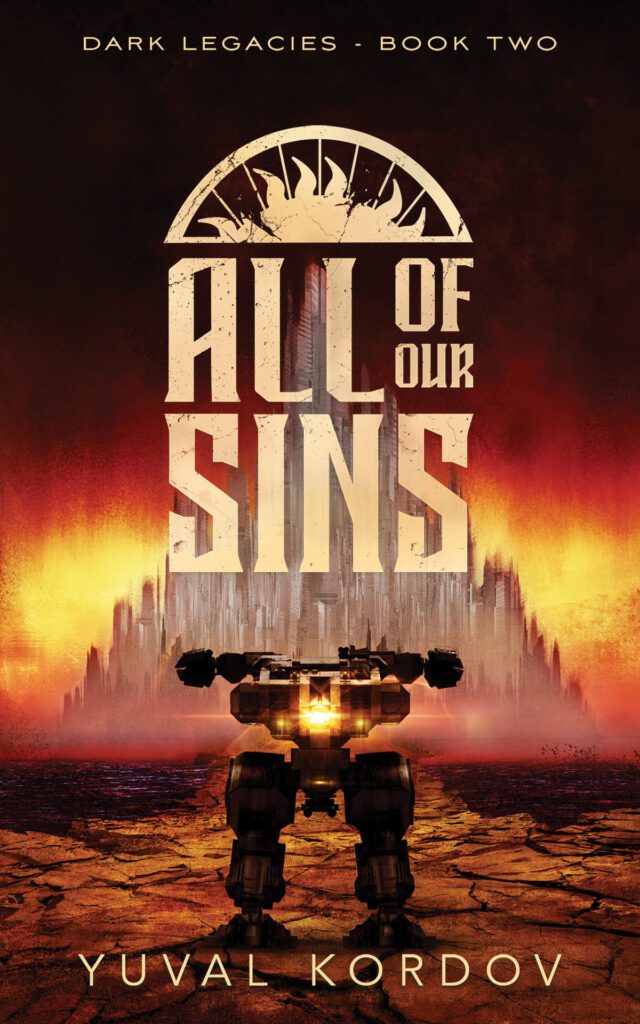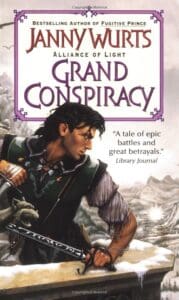
Synopsis
“The mountains became plains, and the seas boiled into deserts.”
So went the earth.
First came the World War, humanity’s suicide. Then came the War against Hell, humanity’s redemption. Esther, the Eternal One, led the way from darkness to light. A new order, by her will.
So went civilization.
For a time. But as history fades and the Eternal One’s yoke tightens, man turns upon man once more. Ancient dreams of independence rise in Cathedral’s shadow. Bastion’s vengeance awakens. War beckons.
And Hell is watching.
Review
I would like to thank the author for providing me with an eARC in return for an honest review.
“We are people of science, yet we allow ourselves to be cowed into superstition.”
All Of Our Sins is the psychotropic fever dream follow-up to The Hand Of God. The Dark Legacies series is proving to be one of the most all-consuming reading experiences I have had. The vivid, dark, and immersive hellscape introduced in book one is further explored in this cerebral and cinematic sequel.
The first thing to say about All Of Our Sins is that, like it’s predecessor, it is a complex and challenging read at times. With it’s non-linear storytelling, dream-like sequences, and intricate plotting through the various POVs, it is sometimes unclear where things are going or what is going on. But this is not a criticism, merely an observation. Trust the author, for he knows what he is doing.
The way in which he executes this style of storytelling is nothing short of genius. He plays on the characters’ sense of reality in a way that makes you stop and question everything you think you know. At times you won’t trust what you’re experiencing as a reader. Time and place are obfuscated by the mind bending narrative. Memories are interspliced into the present, working so well to build intensity of key moments. The story kept me enthralled in ways that many don’t.
Over and over the grisly images repeated.
The book is divided into four parts. Parts one and two are told through two distinct POVs, one for each part. Parts three and four introduce further POVs, which alternate between chapters. This may sound a little chaotic or sporadic to some readers, but, believe me when I say this, it works so well.
The singular POV in part one is a great new character perspective to re-introduce the reader to the dark and claustrophobic, post-apocalyptic world. The dream-nightmare sequences are immediately as trippy, and felt eerily real to me.
The second part, told through the perspective of Mother Rebekah, who we met in book one, is fantastic. Her journey is mesmerising and chilling, that left be hypnotised and breathless.
More tentacles followed it, dozens of them, clambering over the cliff face like a tsunami of the damned. They carried with them uncountable faces, each singing its own tale of agony.
Lovecraftian terrors and creepy pacing gave me the feeling of foreboding and tension – at times I didn’t trust what I experiencing. Time and place are obfuscated, with reveals stealthily threaded through the story.
The world building is superb over these first two parts, especially as we get to learn a little more about the abilities of the revenant sisterhood through the accelerant/lifeblood. Some mysteries from book one are revealed, but only to raise further questions that constantly keep you wanting more from this world.
Further world building in part three focuses on the Union clans. I definitely got some Mad Max vibes here which I appreciated. I particularly enjoyed this storyline with the political plotting between the clans, Bastion, and Cathedral slowly being unravelled – plots within plots.
The complexities of each society are further explored as we learn more about the many factions within Bastion, with its triarchy of government, church and military, along with the many clans of the cave-dwelling Union, and the enigmatic sisterhood and their God engines of Cathedral.
Though eyeless, she was all-seeing. All hearing.
This brings me onto the final part of the book and my favourite character from book one, Rebakah-6. For me, she is the most complex and interesting character in the series and, despite her identity, the most human. A child, whose needs have been neglected and forced into a destiny not of her choosing, she provides some of the most powerful and emotional moments of the story so far. The final chapters are just the icing on the cake, and the ending is a chef’s kiss moment.
Overall, the prose and plot combine perfectly to mirror the world, delivering a metaphysical elegy of humanity’s fall into purgatory. It is a true testament of the author’s skill that he can guide you through his world and story, whilst using nonlinear narratives, multiple POVs, and complex characters – some of which are not even human. This book and series is a triumph of imagination and writing that must be experienced to understand how damn good it is.
Unlike the endless expanse of the Deadlands, I never want this series to end.
All Of Our Sins is due to be published on October 31st.







Leave a Reply